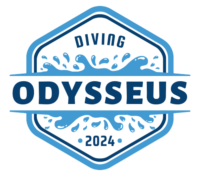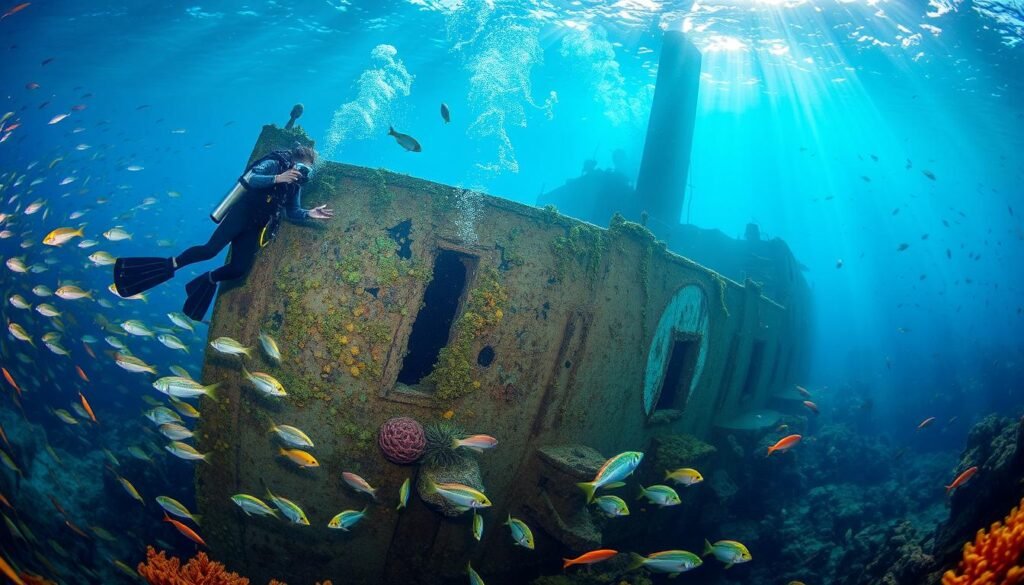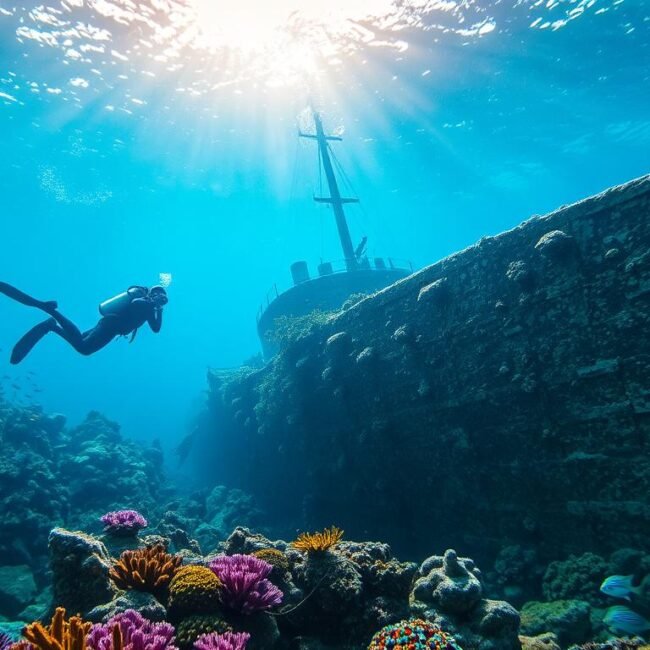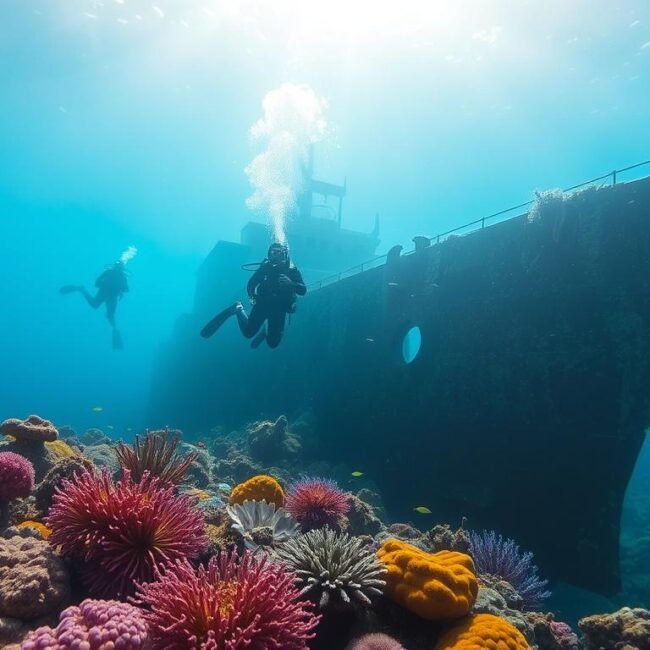“Did you know that around two million shipwrecks lie scattered across the ocean floor?” That stat blew my mind the first time I heard it! I thought, “Wow, there’s a whole other world down there waiting to be discovered,” and that’s what inspired me to explore the fascinating realm of wreck diving. If you’ve ever dreamed about gliding through a sunken vessel, peering into hidden cargo holds, and feeling like a modern-day explorer, then you’re in the right place!
I’m here to chat with you about How to Get Certified for Wreck Diving—why it’s important, how it can boost your scuba skills, and how to pick the right path for your underwater adventures. Wreck diving is not just about looking at rusty metal; it’s a chance to see history frozen in time, to imagine the stories behind each barnacle-encrusted deck or cargo hold. Plus, it’s a total rush to know you’re exploring a site very few people have experienced in person.
However, it’s critical to do it safely. I remember when I first started wreck diving, I almost forgot to double-check my reel before descending. That’s a big no-no. My instructor gently reminded me, “Always trust your gear, but verify it!” After that mild scolding, I made sure to prepare meticulously. In the following sections, I’ll share not just textbook knowledge, but also personal mishaps and triumphant “aha!” moments. I’ll walk you through certifications, training agencies, essential techniques, safety considerations, gear, and even share some cool destinations you might want to check out when you’re ready.
Let’s plunge in (pun intended!) and learn everything you need to know about becoming a wreck diver. By the time you’re done reading, you’ll feel confident and ready to take the plunge. Onward and downward, my friend!
“Wreck diving is a gateway to exploring the past, where each sunken vessel tells a story waiting to be discovered.”
H2: Understanding Wreck Diving Certification
When I first heard about wreck diving certifications, I honestly thought, “Isn’t basic scuba certification enough?” Turns out, wreck diving offers a unique set of thrills—and risks—that go way beyond standard open-water training. In fact, How to Get Certified for Wreck Diving typically starts with a solid scuba foundation, followed by specialized lessons in navigation, buoyancy control, and safety protocols specific to shipwrecks. Let’s break down the essentials of these certifications.
Overview of What a Wreck Diving Certification Entails
Wreck diving certifications typically include theoretical coursework, confined water practice (occasionally), and open-water dives at actual wreck sites. In the classroom portion, you’ll learn about different types of wrecks, potential hazards like entanglement or sharp metal edges, and specialized equipment like reels and line markers. I remember flipping through my manual, completely enthralled by stories of novice divers who kicked up silt or got turned around in dark corridors. That’s when I realized: it’s not enough to rely on intuition down there—solid knowledge is key.
Practically, you’ll practice reel deployment and line handling in a safe environment, sometimes a pool or a shallow lagoon. You’ll simulate how to run a guideline into a wreck and then retrieve it, ensuring you don’t create a tangled spiderweb. This hands-on approach is crucial because once you’re inside a real sunken ship with limited visibility, you want your muscle memory to kick in and guide you out calmly.
Importance of Having a Solid Scuba Foundation Before Specializing
I can’t stress this enough: a wreck diving specialty is an advanced realm. Before you even consider enrolling, you want to be absolutely comfortable with your fundamental scuba skills. Things like buoyancy control, mask clearing, and buddy communication should be second nature.
When you’re exploring the tight corridors of a downed cargo ship or weaving through the beams of a battleship hull, you really can’t afford to be fumbling with your mask or sculling your arms to stay afloat. I once saw a diver who hadn’t quite mastered buoyancy control accidentally kick the overhead with his fins. It dislodged a cloud of rust and silt, creating a zero-visibility nightmare for everyone. Yikes!
Typical Prerequisites and Minimum Experience Requirements
Most agencies need you to be at least an Advanced Open Water diver. You should have 20 to 30 logged dives. Some also want a Deep Diver certification for wrecks in deeper water.
This ensures you’re comfortable with deeper dives and emergency procedures. It’s all about being safe and confident underwater.
There might be an age limit, usually 15 or older. But this can change. Always check with your training agency. If you’re missing something, take your time. Slow and steady is safer and builds confidence.
Differences Between Entry-Level Wreck Diving Courses and Advanced Programs
Entry-level courses focus on “non-penetration” dives. You learn safe approaches and how to respect the wreck and marine life. You might peek inside but won’t explore much.
Advanced courses teach penetration techniques. This is where the excitement grows! You’ll learn about deploying a penetration reel and navigating inside the wreck. You’ll also get into gas management and emergency exits.
These steps prepare you for wreck diving’s unique challenges. Start with the basics and then move to advanced training. It’s more rewarding when done right.
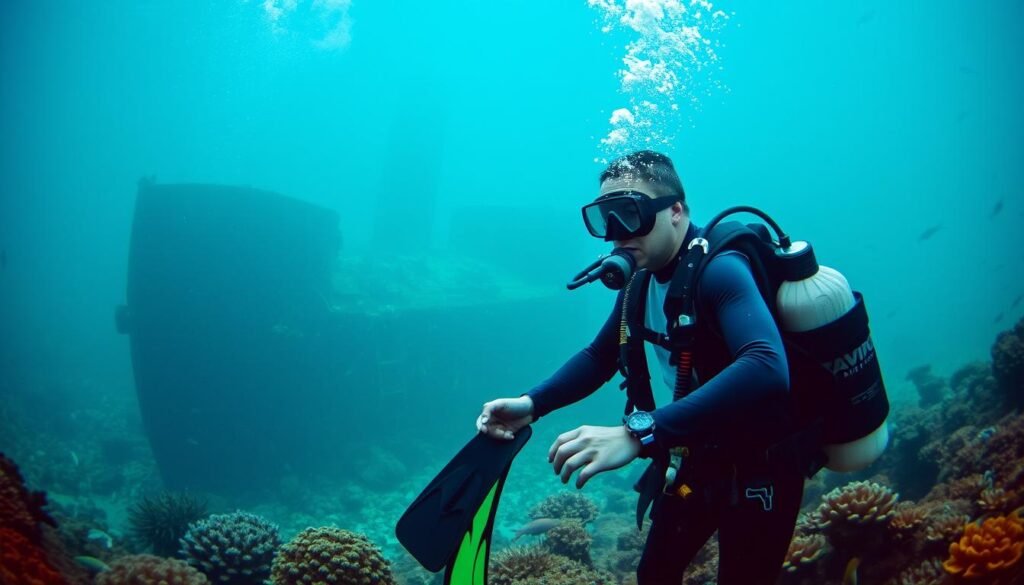
H2: Choosing the Right Training Agency
Choosing a training agency is like picking your favorite ice cream. It’s about taste and quality. PADI, SSI, and NAUI each have their own style and reputation. But how do you choose the best for How to Get Certified for Wreck Diving? Let’s look at it.
Comparing Popular Agencies Like PADI, SSI, and NAUI
PADI is often mentioned because they’re big in recreational diving. They offer standardized courses and have many instructors. SSI is similar, with a global certification and easy online training. NAUI focuses on flexibility, letting instructors tailor courses.
I asked around at my local dive shop when looking for a wreck diving course. Some said PADI for a big name, while others praised NAUI for flexibility. But what really mattered was finding an experienced instructor.
Considering Course Length, Cost, and Location
Course length and cost are important. A wreck diving specialty usually takes two to three days. Prices vary, from a few hundred to over a thousand dollars.
Traveling to a place with lower costs can save money. But make sure the wreck sites match your skill level. You don’t want a bad experience.
Importance of Instructor Expertise and Local Knowledge
Let me share a story with you. I once signed up for a wreck diving course in a warm place. I thought the warm waters would make diving easy. But, the currents were strong, and the instructor was new to wreck dives. It wasn’t very reassuring.
When choosing an instructor, look for those with real experience in wreck diving. They know the local currents and dangers. They can also tailor the training to the wreck you’ll be diving on.
Ensuring Your Certification Is Recognized Worldwide
A certification from a well-known agency is recognized almost everywhere. This is great if you want to dive famous wrecks like the SS Thistlegorm in Egypt. Make sure your certification card is accepted wherever you plan to dive.
The choice depends on what’s available, who’s teaching, and what you prefer. All major agencies follow strict safety and training standards. Do your research, talk to instructors, and trust your instincts. This will help you choose the right agency for your wreck diving certification.
H2: Essential Skills and Techniques
Exploring a sunken ship is thrilling. But, it requires special skills. Learning How to Get Certified for Wreck Diving means mastering buoyancy, line handling, navigation, and emergency procedures.
Buoyancy Control and Finning Techniques for Tight Spaces
Imagine diving through a narrow passageway. A small kick can stir up silt, making it hard to see. I learned this the hard way on my second dive.
Perfecting buoyancy control is key. Practice hovering without moving up or down. Learn finning techniques that don’t disturb the sediment. With practice, navigating through wrecks becomes effortless.
Using Lines and Reels for Safe Wreck Penetration
Lines and reels are like breadcrumbs for wreck divers. They help you find your way back. Always lay a guideline before entering a wreck.
Deploying and retrieving a reel smoothly takes practice. Start in a pool or shallow site. I once tangled my reel, but my instructor said it’s better to learn here than inside a wreck.
Navigational Strategies Within Shipwrecks
Even with a line, wrecks can be confusing. Create a mental map or study schematics. Keep an eye out for landmarks like collapsed bulkheads or distinctive hatches.
If your line has to branch off into different corridors, use line arrows and markers. These small markers help you find the exit. In dark places, they can save your life. Always move slowly and carefully to avoid getting lost.
Emergency Procedures, Including Alternate Exits and Gas Management
Wrecks can change quickly, so be ready for anything. Learn to find other ways out, like open hatches. Practice finding your way back to your line if you lose it.
Managing your air is crucial. You can’t just swim up to the surface if you run out. Use the “rule of thirds” to plan your air: one-third for going in, one-third for coming out, and one-third for emergencies. I once underestimated my air and had a stressful return. Always plan for more air than you think you’ll need.
With skills in buoyancy, reel handling, navigation, and emergency planning, you’ll dive with confidence. Seeing history in a sunken hallway is unforgettable.
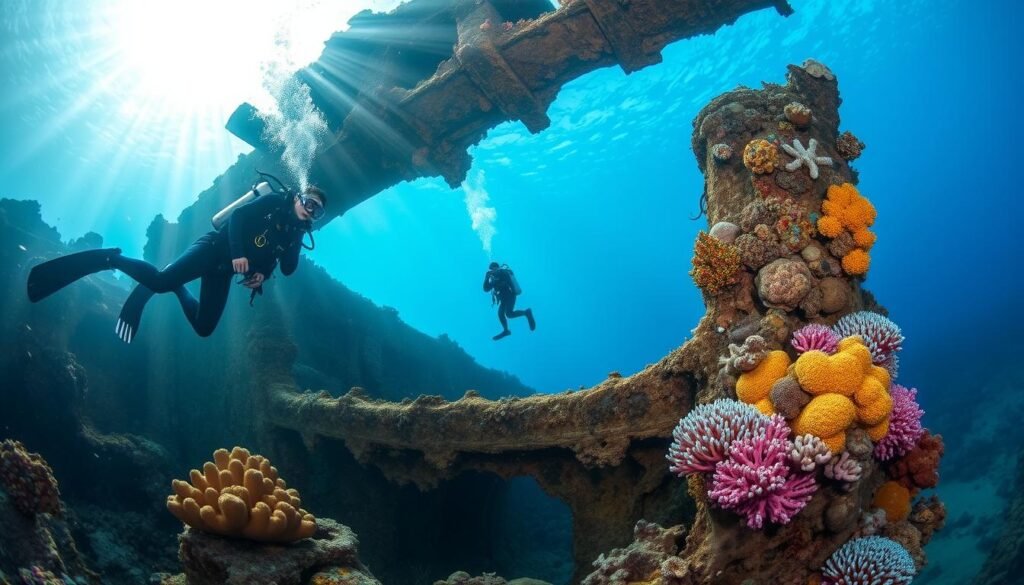
H2: Safety Considerations and Planning
Safety is key when learning How to Get Certified for Wreck Diving. Good planning and respect for the environment can make all the difference. I’ve seen dives go smoothly and others end in chaos. It all comes down to preparation.
Conducting Thorough Research on Dive Sites
Do your research before diving. Learn about the wreck’s history, structure, and dangers. Some wrecks are shallow but tricky, while others are deeper but easier to navigate. I spend hours studying a wreck’s layout before diving.
Online forums and local divers are great sources of information. They can warn you about currents and visibility changes. This helps you plan a safer and more enjoyable dive.
Assessing Environmental Conditions Like Currents and Visibility
Even simple wrecks can be tough with strong currents or poor visibility. Always check the weather and talk to local experts. I once dove during a bad visibility season and it was a disaster. Always listen to local advice.
Importance of Having a Reliable Dive Buddy or Guide
Wreck diving is safer with a buddy or guide. They should be as skilled as you are. A bad buddy can make a dive dangerous. Always dive with someone you can count on.
Before you dive, make sure you and your buddy agree on signals, route, and emergency procedures. Good communication is key. You don’t want to be in the dark, trying to guess what your buddy is trying to say.
Gear Maintenance and Pre-Dive Equipment Checks
Let’s talk about your gear. Make sure everything is in top shape before you dive. This includes your regulator, BCD, flashlight, and reel. Remember, “Take care of your gear, and it’ll take care of you.”
I once had a close call when my dive light went out. I had forgotten to charge it. Luckily, my backup light worked, but it was a scare.
Make a checklist to ensure everything is ready. Check your tanks are filled right and your gear is in good condition. This includes your regulator hoses, BCD, and reel. Also, test your lights and bring spares. A little extra time for checks can save you a lot of trouble.
With research, the right gear, and a good buddy, you’re set for a safe dive. It might seem like a lot of work, but it’s worth it. You’ll be glad you did all the prep when you’re exploring an old ship.
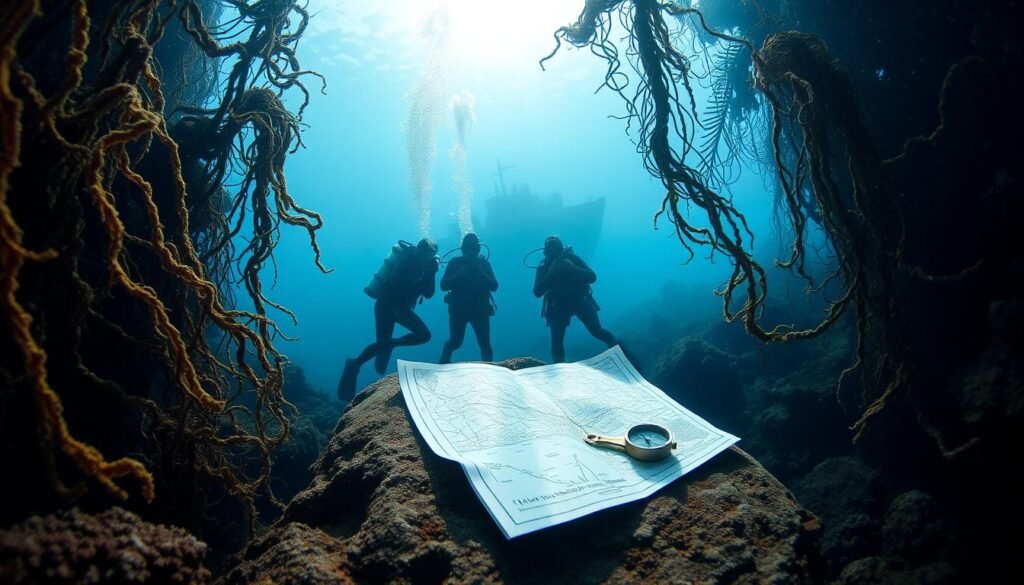
H2: Recommended Gear for Wreck Diving
When people ask about How to Get Certified for Wreck Diving, the talk quickly turns to gear. The right equipment is crucial for a good wreck diving experience. You’ll need everything from exposure suits to gadgets to stay safe and comfortable.
Choosing the Right Wetsuit or Drysuit for Your Local Waters
Staying warm is key. In warm waters, a 3mm or 5mm wetsuit works well. But for colder waters, like the Pacific Northwest or Great Lakes, a drysuit is better. Drysuits keep you dry and warm.
My first cold-water dive was tough. My wetsuit was too thin, and I was shivering. Then, I tried a drysuit and it changed everything.
Essential Accessories: Dive Lights, Reels, Line Markers, Slates
Wrecks are often dark, especially below decks. A strong dive light is a must. Choose one with high lumen output and a narrow beam. Always carry a backup light, too.
Reels and line markers help you navigate wrecks. They mark your path, ensuring you can find your way out. They’re crucial when you’re deep inside a wreck.
A slate or wet notes are also important. They help you jot down notes or maps in the dark. Once, we found a hidden chamber and used a slate to record its layout.
Utilizing Advanced Dive Computers for Depth and Bottom Time Management
For deep dives, you need a special dive computer. These computers handle multiple gases, customize settings, and have digital compasses. They also store dive profiles for future reference.
Advanced computers adjust safety stops based on your dive. During a training dive, my computer helped me avoid a problem by adjusting my safety stop.
Proper Care and Storage of Specialized Wreck Diving Gear
Wreck diving gear faces a lot of challenges. Saltwater, rust, and sharp edges can damage it. Rinse your gear in fresh water after each dive. Store reels without twisted lines and check for frays.
I once forgot to rinse my reel and it corroded. Now, I always rinse my gear to keep it in good shape.
The right gear can make wreck diving exciting, not scary. You’ll need a good exposure suit, a strong reel, and a reliable dive computer. Quality equipment is key, and it could save your life.
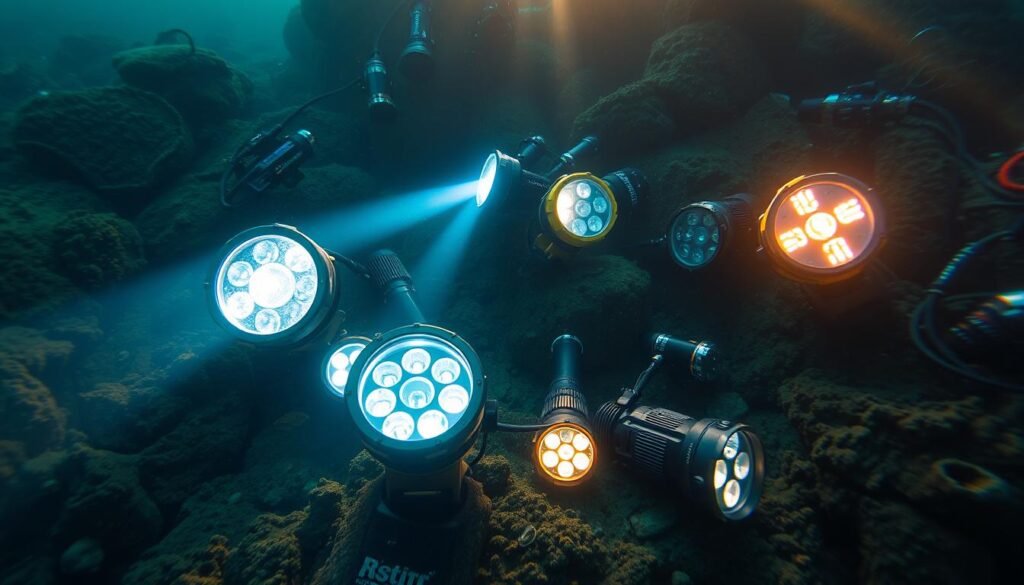
H2: Practical Tips for Your First Wreck Dive
Exploring a sunken ship for the first time is thrilling and a bit scary. My stomach was full of excitement and a bit of fear as I dove into the wreck. If you’re about to try wreck diving for the first time, here are some tips from my own experiences.
How to Prepare Mentally and Physically
Learn about the wreck you’ll dive. Look at photos, talk to divers, or watch videos. Knowing what to expect can help calm your nerves. If you get nervous, try slow breathing exercises before diving.
Stay hydrated and well-rested before diving. Dehydration can increase the risk of sickness. Also, stretch before diving to avoid muscle strain.
Importance of Gradual Progression: From Simple Swim-Throughs to Complex Penetrations
When I got my wreck diving certification, I wanted to dive into the ship’s darkest corners right away. But my instructor said to start slow. Begin by swimming around the wreck and then try simple swim-throughs.
Only attempt complex dives after you’ve done some simpler ones. Practice using guidelines and buoyancy in a safe setting. Building confidence is key.
Respecting Marine Life and Preserving Historical Artifacts
Wrecks are home to marine life and should be respected. Avoid touching coral and don’t remove artifacts. Some wrecks are protected sites, and removing items is illegal and unethical.
Dealing with Potential Challenges Like Entanglement or Limited Visibility
Be careful of entanglement hazards like nets and cables. Always watch for lines that might snag your gear. If you get tangled, stay calm and carefully untangle yourself.
For limited visibility, use your reel line to guide you back. Move slowly, keep your buddy in sight, and use a dive light to see through the murk.
With these tips, your first wreck dive will be an adventure, not a nerve-wracking test. You might feel your heart beat fast as you enter the hull for the first time. But that rush is what makes wreck diving so addictive. After one dive, you’ll be planning your next underwater adventure.
Proper use of specialized equipment is crucial for safe wreck exploration and is covered extensively in wreck diving courses.
H2: Popular Wreck Diving Destinations
There are many sunken treasures around the world, each offering a unique glimpse into history. If you’re thinking about How to Get Certified for Wreck Diving and want to dive some famous sites, I’ve got you covered. From old World War II ships to modern reefs, there’s a wreck waiting for you.
Highlighting Top Wreck Dive Sites Around the World (e.g., SS Thistlegorm, USS Kittiwake)
- SS Thistlegorm (Egypt): This World War II cargo ship is a top wreck dive site. It’s filled with old motorcycles, trucks, and ammunition from 1941. Exploring its cargo holds feels like stepping back in time.
- USS Kittiwake (Cayman Islands): A former submarine rescue vessel, the Kittiwake was sunk in 2011 to create an artificial reef. It’s shallow, making it perfect for beginners. The clear waters offer great visibility and a spacious interior for exploration.
- Zenobia (Cyprus): A massive ferry that sank in 1980, the Zenobia has stunning corridors and trucks still on the decks. Diving inside can be challenging, but the outside is breathtaking. Schools of fish and clear waters make it a favorite spot.
Regional Considerations Like Water Temperature, Marine Life, and Accessibility
In tropical waters like the Caribbean, you’ll find warm temperatures and colorful reefs. But, you might face crowds. In colder places like the Great Lakes or the U.K., wrecks are well-preserved. However, you’ll need more protection against the cold.
Getting to some wrecks is easy, while others require a long trip. Make sure your travel plans match the site you want to visit.
Travel Planning Tips: Peak Seasons, Local Regulations, and Recommended Outfitters
- Peak Seasons: Find the best time to visit your wreck. Avoid monsoon or hurricane seasons. Shoulder seasons offer good weather and fewer people.
- Local Regulations: Some wrecks are protected. Always follow local rules to avoid fines or being banned.
- Recommended Outfitters: Choose dive centers with experienced instructors and good safety records. A good outfitter will handle everything and know the wreck well. Don’t hesitate to ask questions before booking.
Wherever you dive, wrecks offer a unique look into history. They’re often home to marine life, turning old wrecks into thriving reefs. Each dive is a chapter in the sea’s story, making you part of it. So, take your wreck diving skills on the road or under the sea and enjoy the wonders these places offer.
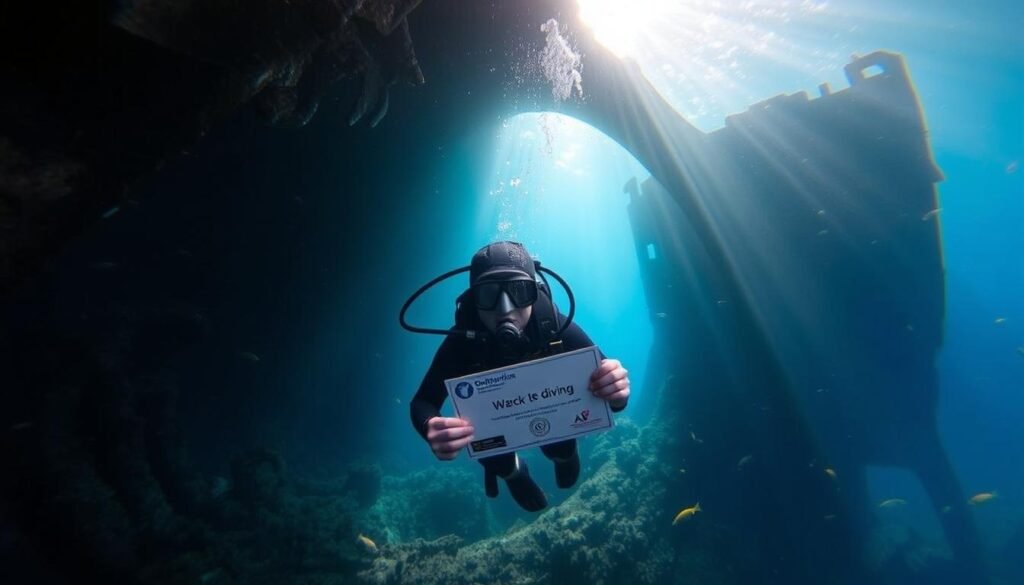
“Wreck diving is more than just exploring sunken ships – it’s a window into the past, a chance to uncover the stories hidden beneath the waves.” – John Doe, Renowned Wreck Diver
Conclusion
Wreck diving is a mix of history, adventure, and marine exploration. Learning How to Get Certified for Wreck Diving opens a world hidden beneath the waves. Here, ships, submarines, and planes rest in silent beauty. It’s a journey that requires respect, preparation, and the right mindset, but the rewards are huge.
Whether you’re starting with basic courses or advanced dives, adapt your training to your pace. Always prioritize safety by checking your gear and staying aware of your surroundings. Dive with a reliable buddy and research local regulations for far-off sites.
The best part of wreck diving is making it your own. Some love shallow wrecks full of fish, while others prefer deeper dives. Treat the wrecks with respect. They’re not just metal under the sea; they’re windows into the past, full of stories.
Are you ready to start your underwater journey? I’d love to hear about your favorite wrecks, your training, or any exciting stories. Share your experiences or questions in the comments below. Let’s grow our community of curious wreck divers. Dive smart, dive safe, and dive with awe for the hidden worlds we explore!
FAQs
Do I need an Advanced Open Water certification before starting a wreck diving course?
Many agencies recommend (or require) an Advanced Open Water certification before wreck diving. This ensures you’re comfortable with deeper dives and emergency procedures. If you’re new to diving, log more dives and gain confidence first.
How long does it take to get certified for wreck diving?
Wreck diving courses usually take two or three days. The exact time depends on the agency and your instructor. You’ll learn in class, practice in confined water, and dive on a wreck. If your schedule is tight, you can spread the course over weekends.
Is it dangerous to penetrate a wreck if I’m still learning?
Penetrating a wreck is risky, with dangers like silt-outs and overhead environments. Most agencies offer non-penetration and penetration phases. If you’re still learning, start with outside-exploration dives until you’re comfortable with all the skills.
What kind of gear do I absolutely need for a wreck dive?
A reliable dive light (plus a backup) is key for exploring dark corners. You’ll also need a reel and line markers for safe navigation. Your standard scuba gear—like a well-maintained regulator and BCD—is a good start.
For cold or deep dives, consider a drysuit and advanced dive computer. They add safety and comfort.
How do I pick the right training agency for wreck diving?
Agencies like PADI, SSI, and NAUI offer great wreck diving programs. Your choice might depend on what’s available locally and the instructor’s experience. Look for a course that matches your budget and schedule.
Talk to potential instructors before signing up. Ask about their wreck diving experience, class size, and knowledge of the sites. A good instructor can greatly enhance your wreck diving experience.
